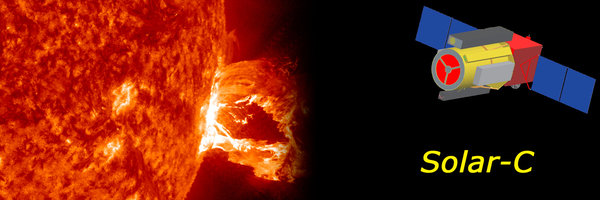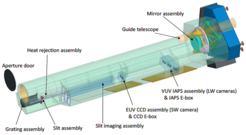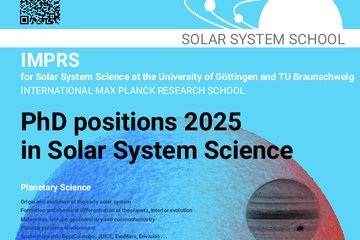
Solar-C - The Next Generation Solar Physics Mission
Solar-C is a proposed solar mission of JAXA (Japan Aerospace Exploration Agency) as successor of the very successful Solar-B mission (Hinode). After several years of conceptual and feasibility studies, the efforts have been directed into a lighter incarnation featuring the original VUV spectrograph (EUVST/LEMUR) plus a multi-channel imaging system, called Solar-C_EUVST. This decision was also supported by the ESA, JAXA, NASA chartered Next Generation Solar Physics Mission (NGSPM) Science Objectives Team (SOT). The NGSPM-SOT had the goal to study and report on a multilateral solar physics mission concept. Although the panel reported flying the full Solar-C concept (see below) as the highest scientific priority, it also recommended pursuing the science objectives by flying the instruments on separate, thus smaller and cheaper, missions as a viable opportunity. Among the instuments forming the payload of the full Solar-C, the spectrograph was the one with the highest scientific priority.
The Solar-C_EUVST mission
The scientific goal of Solar-C_EUVST is to investigate the energetics and dynamics of the solar atmosphere based on high spatial resolution, high throughput, high cadence spectroscopic and imaging observations seamlessly from the chromosphere to the corona.
The mission implementation is being pursued by an international consortium led by Japan and including institutes and laboratories in Japan, the United States and Europe.
At the beginning of 2018 Solar-C_EUVST has been proposed to JAXA for a launch opportunity in 2025. The proposal (Science case and requirements; Technical description) has been selected for pre phase-A study.
Very recently, a proposal has been submitted to NASA as Mission of Opportunity for hardware support to Solar-C_EUVST and is now awaiting evaluation.
The mission science goals, according to the JAXA proposal are expressed by the following questions:
- How do fundamental processes lead to the formation of the solar atmosphere and the solar wind?
- How does the solar atmosphere become unstable, releasing the energy that drives solar flares and eruptions?
These questions will be answered by Solar-C_EUVST by:

- seamlessly observing, at the same time, all the temperature regimes of the solar atmosphere from the chromosphere to the corona,
- resolving elemental structures of the solar atmosphere with high spatial resolution and cadence to track their evolution,
- obtaining spectroscopic information on the dynamics of elementary processes taking place in the solar atmosphere.
MPS contributions to the scientific payload
EUVST/LEMUR is a two-element optics design (as for the EIS/Hinode and SPICE/Solar orbiter spectrometers) where the absence of an entrance filter, optimized broad-band multilayer coatings for the optics and intensified cameras for the long wavelength bands yield the unprecedented throughput that is needed for high spatial and temporal spectroscopy. The instrument records spectra simultaneously over four wavelength ranges from the EUV to the FUV.

| Band | Spectral coverage |
| SW | 170-215 Å |
| LW-1 | 690-850 Å |
| LW-2 | 925-1085 Å (2nd order: 463-542 Å) |
| LW-3 | 1115-1275 Å (2nd order: 557-637 Å) |
MPS has played an important role in the definition and development of the EUVST since the early stages of the project. In 2010 an international team lead by the MPS proposed that ESA provide the EUVST as a European contribution to Solar-C under the name of LEMUR. The proposal did receive a positive evaluation by the ESA advisory structure. Over the years the instrument design has been further refined, reaching a very high level of maturity evinced in the proposals submitted in 2018. The MPS goal is to provide relevant subsystems and to play an important role in the testing and characterization of the instrument making use of its state-of-the-art facilities.
The large Solar-C mission
The large Solar-C mission is thought as a comprehensive solar observatory capable of studying the solar atmosphere as an integrated system by establishing the dynamical coupling between its various temperature regions (e.g., by following the flow of mass and energy from the photosphere to the corona). Its goals are achieved by a payload consisting of:
- a Solar Ultraviolet, Visible, and Infrared Telescope (SUVIT) for spectropolarimetry of the photosphere and chromosphere of the Sun. With a diameter of 1.5 m, it will be the largest solar telescope to fly in space by a factor of 9 in collecting area.
- an X-ray or extreme-ultraviolet imaging telescope (XIT) that will observe the corona at unprecedented spatial resolution.
- the EUVST/LEMUR extreme ultraviolet spectroscopic telescope with a resolution and effective area an order of magnitude higher than currently available for solar studies.
With the decision of implementing EUVST/LEMUR on a smaller, dedicated mission, the large Solar-C is now on indefinite hold. However, interest remains very high, especially for the SUVIT intrument. It is not excluded that SUVIT could later also be proposed for implementation on a dedicated smaller mission.
SUVIT: It is a 1.5 m Gregory-Telescope achieving a resolution of about 70 km. Its focal plane instrumentation includes a broad-band and a narrow-band imager (filtergraph). It also includes a spectropolarimeter.

The MPS goal is to develop and build key components of the spectropolarimeter such as the grating and detectors.














